(完整版)《介词的用法》讲解
- 格式:ppt
- 大小:186.50 KB
- 文档页数:4
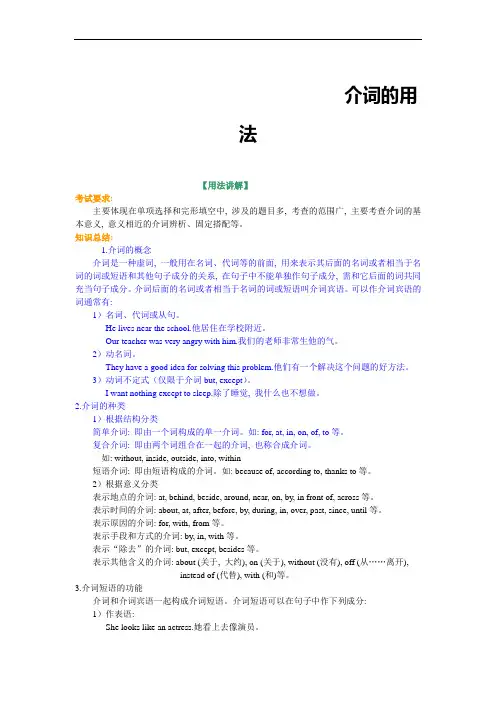
介词的用法【用法讲解】考试要求:主要体现在单项选择和完形填空中, 涉及的题目多, 考查的范围广, 主要考查介词的基本意义, 意义相近的介词辨析、固定搭配等。
知识总结:1.介词的概念介词是一种虚词, 一般用在名词、代词等的前面, 用来表示其后面的名词或者相当于名词的词或短语和其他句子成分的关系, 在句子中不能单独作句子成分, 需和它后面的词共同充当句子成分。
介词后面的名词或者相当于名词的词或短语叫介词宾语。
可以作介词宾语的词通常有:1)名词、代词或从句。
He lives near the school.他居住在学校附近。
Our teacher was very angry with him.我们的老师非常生他的气。
2)动名词。
They have a good idea for solving this problem.他们有一个解决这个问题的好方法。
3)动词不定式(仅限于介词but, except)。
I want nothing except to sleep.除了睡觉, 我什么也不想做。
2.介词的种类1)根据结构分类简单介词: 即由一个词构成的单一介词。
如: for, at, in, on, of, to等。
复合介词: 即由两个词组合在一起的介词, 也称合成介词。
如: without, inside, outside, into, within短语介词: 即由短语构成的介词。
如: because of, according to, thanks to等。
2)根据意义分类表示地点的介词: at, behind, beside, around, near, on, by, in front of, across等。
表示时间的介词: about, at, after, before, by, during, in, over, past, since, until等。
表示原因的介词: for, with, from等。
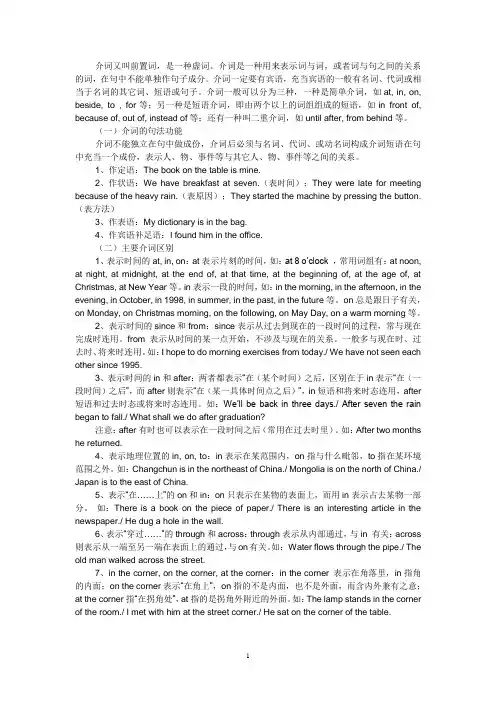
介词又叫前置词,是一种虚词。
介词是一种用来表示词与词,或者词与句之间的关系的词,在句中不能单独作句子成分。
介词一定要有宾语,充当宾语的一般有名词、代词或相当于名词的其它词、短语或句子。
介词一般可以分为三种,一种是简单介词,如at, in, on, beside, to , for等;另一种是短语介词,即由两个以上的词组组成的短语,如in front of, because of, out of, instead of等;还有一种叫二重介词,如until after, from behind等。
(一)介词的句法功能介词不能独立在句中做成份,介词后必须与名词、代词、或动名词构成介词短语在句中充当一个成份,表示人、物、事件等与其它人、物、事件等之间的关系。
1、作定语:The book on the table is mine.2、作状语:We have breakfast at seven.(表时间);They were late for meeting because of the heavy rain.(表原因);They started the machine by pressing the button.(表方法)3、作表语:My dictionary is in the bag.4、作宾语补足语:I found him in the office.(二)主要介词区别1、表示时间的at, in, on:at表示片刻的时间,如:at 8 o’clock ,常用词组有:at noon, at night, at midnight, at the end of, at that time, at the beginning of, at the age of, at Christmas, at New Year等。
in表示一段的时间,如:in the morning, in the afternoon, in the evening, in October, in 1998, in summer, in the past, in the future等。
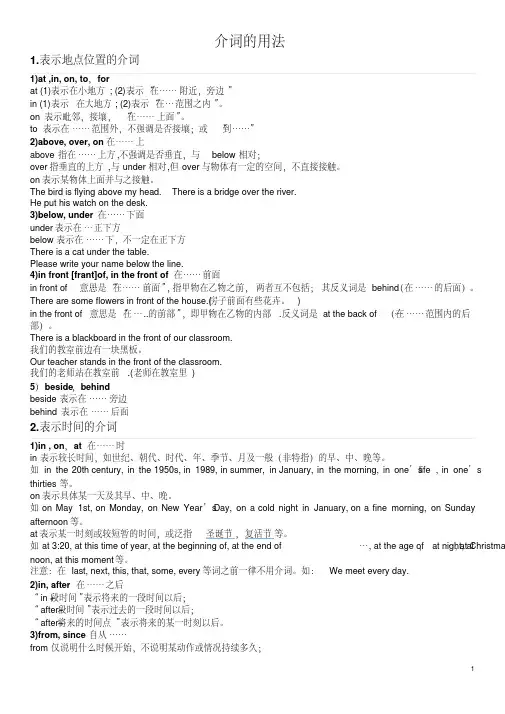
介词的用法1.表示地点位置的介词1)at ,in, on, to,forat (1)表示在小地方; (2)表示“在……附近,旁边”in (1)表示在大地方; (2)表示“在…范围之内”。
on 表示毗邻,接壤,“在……上面”。
to 表示在……范围外,不强调是否接壤;或“到……”2)above, over, on 在……上above 指在……上方,不强调是否垂直,与below相对;over指垂直的上方,与under相对,但over与物体有一定的空间,不直接接触。
on表示某物体上面并与之接触。
The bird is flying above my head. There is a bridge over the river.He put his watch on the desk.3)below, under 在……下面under表示在…正下方below表示在……下,不一定在正下方There is a cat under the table.Please write your name below the line.4)in front [frant]of, in the front of在……前面意思是“在……前面”,指甲物在乙物之前,两者互不包括;其反义词是behind(在……的后面)。
in front of…There are some flowers in front of the house.(房子前面有些花卉。
)in the front of 意思是“在…..的前部”,即甲物在乙物的内部.反义词是at the back of…(在……范围内的后部)。
There is a blackboard in the front of our classroom.我们的教室前边有一块黑板。
Our teacher stands in the front of the classroom.我们的老师站在教室前.(老师在教室里)5)beside,behindbeside 表示在……旁边behind 表示在……后面2.表示时间的介词1)in , on,at 在……时in表示较长时间,如世纪、朝代、时代、年、季节、月及一般(非特指)的早、中、晚等。
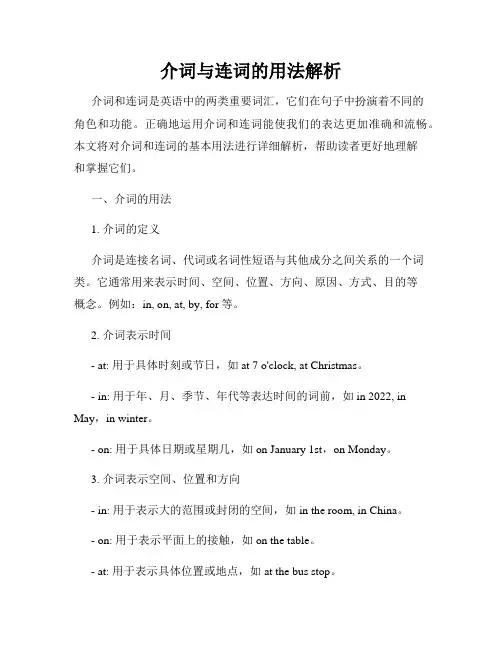
介词与连词的用法解析介词和连词是英语中的两类重要词汇,它们在句子中扮演着不同的角色和功能。
正确地运用介词和连词能使我们的表达更加准确和流畅。
本文将对介词和连词的基本用法进行详细解析,帮助读者更好地理解和掌握它们。
一、介词的用法1. 介词的定义介词是连接名词、代词或名词性短语与其他成分之间关系的一个词类。
它通常用来表示时间、空间、位置、方向、原因、方式、目的等概念。
例如:in, on, at, by, for等。
2. 介词表示时间- at: 用于具体时刻或节日,如at 7 o'clock, at Christmas。
- in: 用于年、月、季节、年代等表达时间的词前,如in 2022, in May,in winter。
- on: 用于具体日期或星期几,如on January 1st,on Monday。
3. 介词表示空间、位置和方向- in: 用于表示大的范围或封闭的空间,如in the room, in China。
- on: 用于表示平面上的接触,如on the table。
- at: 用于表示具体位置或地点,如at the bus stop。
4. 介词表示原因、方式和目的- for: 表示目的或原因,如for fun, for the sake of。
- by: 表示方式、方法或通过某种手段,如by bus, by email。
二、连词的用法1. 连词的定义连词是连接词语、短语或句子的词类。
它用于连接并列成分、并列句、主从句等,起到使句子结构更加完整和连贯的作用。
例如:and, but, or, so等。
2. 并列连词- and: 用于连接同类词、词组和句子,表示并列关系,如I like apples and oranges。
- but: 表示转折或对比关系,如She is smart but lazy。
- or: 表示选择关系,如Do you want tea or coffee?3. 从属连词- because: 引导原因状语从句,如I stayed at home because it was raining。
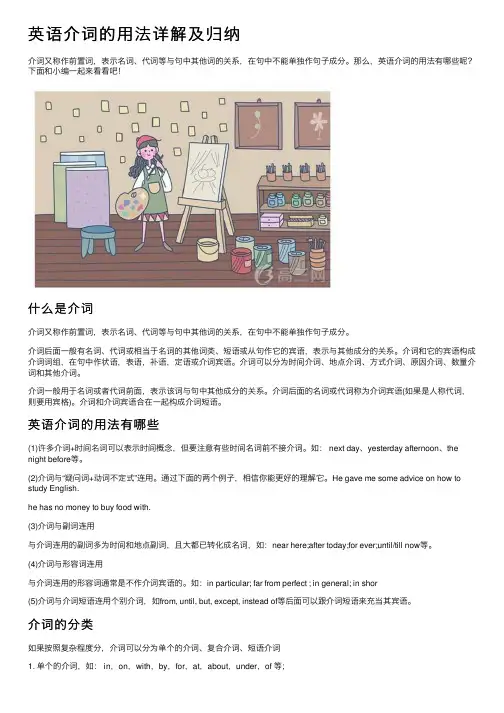
英语介词的⽤法详解及归纳介词⼜称作前置词,表⽰名词、代词等与句中其他词的关系,在句中不能单独作句⼦成分。
那么,英语介词的⽤法有哪些呢?下⾯和⼩编⼀起来看看吧!什么是介词介词⼜称作前置词,表⽰名词、代词等与句中其他词的关系,在句中不能单独作句⼦成分。
介词后⾯⼀般有名词、代词或相当于名词的其他词类、短语或从句作它的宾语,表⽰与其他成分的关系。
介词和它的宾语构成介词词组,在句中作状语,表语,补语,定语或介词宾语。
介词可以分为时间介词、地点介词、⽅式介词、原因介词、数量介词和其他介词。
介词⼀般⽤于名词或者代词前⾯,表⽰该词与句中其他成分的关系。
介词后⾯的名词或代词称为介词宾语(如果是⼈称代词,则要⽤宾格)。
介词和介词宾语合在⼀起构成介词短语。
英语介词的⽤法有哪些(1)许多介词+时间名词可以表⽰时间概念,但要注意有些时间名词前不接介词。
如: next day、yesterday afternoon、the night before等。
(2)介词与“疑问词+动词不定式”连⽤。
通过下⾯的两个例⼦,相信你能更好的理解它。
He gave me some advice on how to study English.he has no money to buy food with.(3)介词与副词连⽤与介词连⽤的副词多为时间和地点副词,且⼤都已转化成名词,如:near here;after today;for ever;until/till now等。
(4)介词与形容词连⽤与介词连⽤的形容词通常是不作介词宾语的。
如:in particular; far from perfect ; in general; in shor(5)介词与介词短语连⽤个别介词,如from, until, but, except, instead of等后⾯可以跟介词短语来充当其宾语。
介词的分类如果按照复杂程度分,介词可以分为单个的介词、复合介词、短语介词1. 单个的介词,如: in,on,with,by,for,at,about,under,of 等;2. 复合介词,例如:into,within,throughout,inside,outside,without 等;3. 短语介词,如:out of, because of, away from, on top of, ever since, next to, according to, in front of 等。
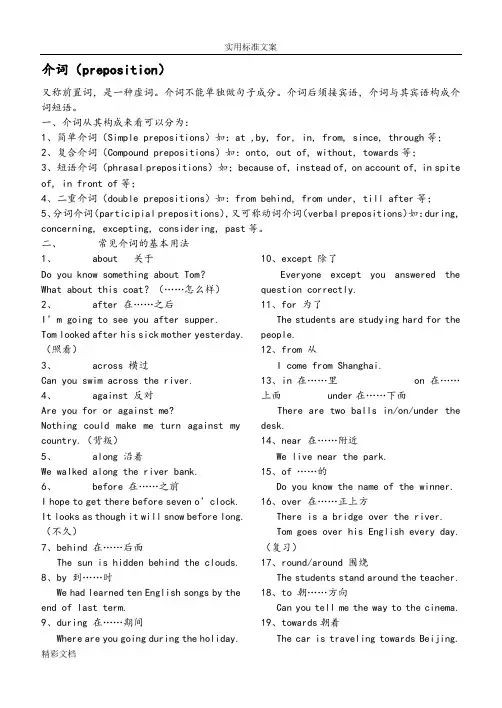
介词(preposition)又称前置词,是一种虚词。
介词不能单独做句子成分。
介词后须接宾语,介词与其宾语构成介词短语。
一、介词从其构成来看可以分为:1、简单介词(Simple prepositions)如:at ,by, for, in, from, since, through等;2、复合介词(Compound prepositions)如:onto, out of, without, towards等;3、短语介词(phrasal prepositions)如;because of, instead of, on account of, in spite of, in front of等;4、二重介词(double prepositions)如:from behind, from under, till after等;5、分词介词(participial prepositions),又可称动词介词(verbal prepositions)如:during, concerning, excepting, considering, past等。
二、常见介词的基本用法1、 about 关于Do you know something about Tom?What about this coat?(……怎么样)2、 after 在……之后I’m going to see you after supper. Tom looked after his sick mother yesterday.(照看)3、 across 横过Can you swim across the river.4、 against 反对Are you for or against me?Nothing could make me turn against my country.(背叛)5、 along 沿着We walked along the river bank.6、 before 在……之前I hope to get there before seven o’clock. It looks as though it will snow before long.(不久)7、behind 在……后面The sun is hidden behind the clouds.8、by 到……时We had learned ten English songs by the end of last term.9、during 在……期间Where are you going during the holiday. 10、except 除了Everyone except you answered the question correctly.11、for 为了The students are studying hard for the people.12、from 从I come from Shanghai.13、in 在……里 on 在……上面 under在……下面There are two balls in/on/under the desk.14、near 在……附近We live near the park.15、of ……的Do you know the name of the winner.16、over 在……正上方There is a bridge over the river.Tom goes over his English every day.(复习)17、round/around 围绕The students stand around the teacher.18、to 朝……方向Can you tell me the way to the cinema.19、towards朝着The car is traveling towards Beijing.20、with 和……一起me?Would you like to go to the cinema with学习这些介词时可以先记住它的汉语意思,然后参照例句来加深理解,并在今后的学习中加以灵活运用。
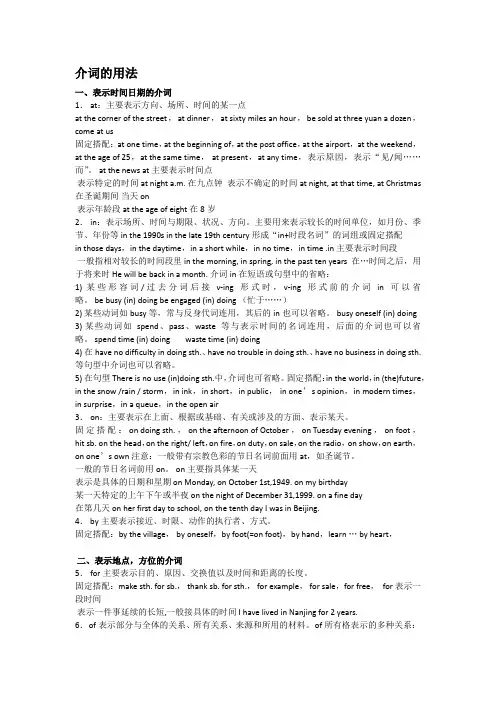
介词的用法一、表示时间日期的介词1.at:主要表示方向、场所、时间的某一点at the corner of the street,at dinner,at sixty miles an hour,be sold at three yuan a dozen,come at us固定搭配:at one time,at the beginning of,at the post office,at the airport,at the weekend,at the age of25,at the same time,at present,at any time,表示原因,表示“见/闻……而”。
at the news at主要表示时间点表示特定的时间at night a.m.在九点钟表示不确定的时间at night,at that time,at Christmas 在圣诞期间当天on表示年龄段at the age of eight在8岁2.in:表示场所、时间与期限、状况、方向。
主要用来表示较长的时间单位,如月份、季节、年份等in the1990s in the late19th century形成“in+时段名词”的词组或固定搭配in those days,in the daytime,in a short while,in no time,in time.in主要表示时间段一般指相对较长的时间段里in the morning,in spring,in the past ten years在…时间之后,用于将来时He will be back in a month.介词in在短语或句型中的省略:1)某些形容词/过去分词后接v-ing形式时,v-ing形式前的介词in可以省略。
be busy(in)doing be engaged(in)doing(忙于……)2)某些动词如busy等,常与反身代词连用,其后的in也可以省略。
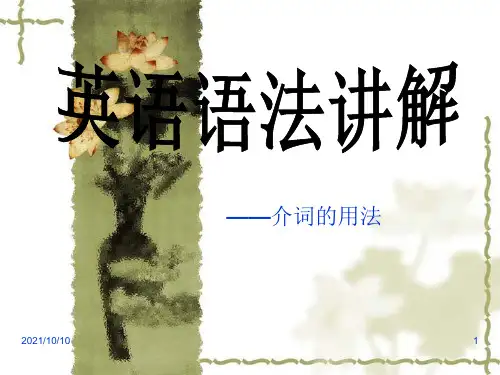
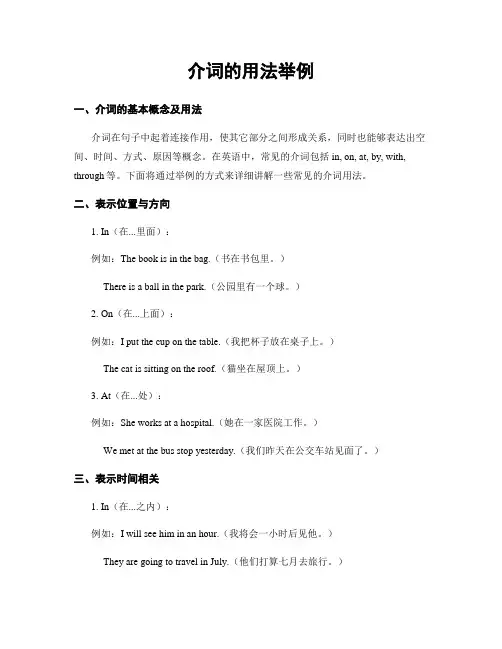
介词的用法举例一、介词的基本概念及用法介词在句子中起着连接作用,使其它部分之间形成关系,同时也能够表达出空间、时间、方式、原因等概念。
在英语中,常见的介词包括in, on, at, by, with, through等。
下面将通过举例的方式来详细讲解一些常见的介词用法。
二、表示位置与方向1. In(在...里面):例如:The book is in the bag.(书在书包里。
)There is a ball in the park.(公园里有一个球。
)2. On(在...上面):例如:I put the cup on the table.(我把杯子放在桌子上。
)The cat is sitting on the roof.(猫坐在屋顶上。
)3. At(在...处):例如:She works at a hospital.(她在一家医院工作。
)We met at the bus stop yesterday.(我们昨天在公交车站见面了。
)三、表示时间相关1. In(在...之内):例如:I will see him in an hour.(我将会一小时后见他。
)They are going to travel in July.(他们打算七月去旅行。
)2. On(在某日或某时刻):例如:We have a meeting on Monday morning. (我们星期一上午有个会议。
) The train will arrive on time.(火车将准时到达。
)3. At(在某个具体的时刻):例如:They usually have lunch at noon.(他们通常中午吃饭。
)We will meet at 7 p.m.(我们将在晚上七点见面。
)四、表示方式与原因1. By(通过...方式):例如:He goes to work by car every day.(他每天乘车去上班。
)I communicate with my friends by email.(我通过电子邮件和朋友们沟通。

中考英语介词的用法讲解一、知识框架二、知识点梳理一、定义:介词:是一种用来表示词与词、词与句之间的关系的词,在句中不能单独作句子成分。
二、介词短语的句法作用1、介词短语相当于一个形容词或副词,可用作状语、定语和表语。
如:The man came <down the stairs>.(状)The woman <with a flower on her head> is from the countryside.(定)The teacher is now with the pupils.(表)(老师现在和学生在一起)2、介词短语在句子中的位置:介词短语做状语时,如果表示时间/地点,可以放在句首或句尾。
如果表示方向/方式/伴随/涉及/原因/目的/比较,一般放在句尾;介词短语作表语时放在连系动词之后;介词短语作定语时,只能放在被修饰的名词之后。
如:He wanted to find a good job in Shanghai the next year.(状语)They searched the room for the thief.The letters are for you.(表语)Have you seen a cat with a black head and four white legs?(定语)三、介词用法(一)表时间的介词:1.at通常用于:(表示在某个时刻或者瞬间)at+时间点,节日(泛指圣诞节、新年等整个假期时,要用at)如:at 7:30; at lunch time; at Christmas 在圣诞节期间固定词组搭配:at dawn, at night, at midnight, at noon, at that time, at the moment2. on通常用于:(表示在具体的某一天或者某天的上下午等)on+具体时间(日期,星期几)on October 1st ; on Monday; on a rainy morning; on Teachers’ Dayon Christmas Day 在圣诞节这一天3. in通常用于:(表示在一段时间里)①in+世纪/年/月/季节/早/中/晚in the 20th century, in the late 18th century②特定的年龄段,in his thirties (在他30多岁时)补充1:表示“在一段时间之后”,句子常用一般将来时。
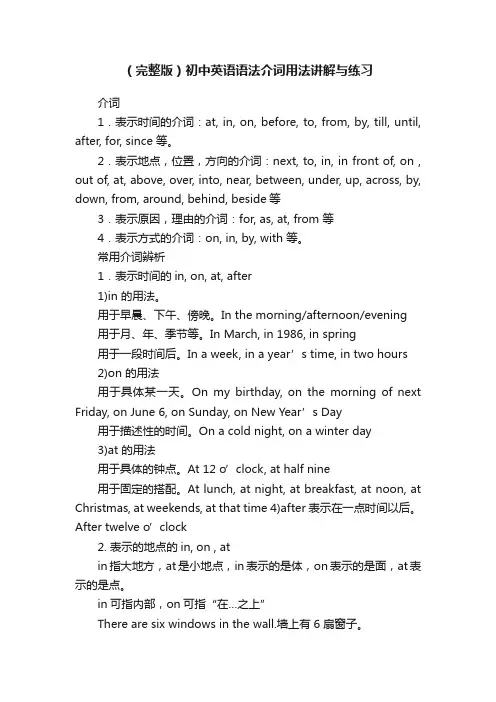
(完整版)初中英语语法介词用法讲解与练习介词1.表示时间的介词:at, in, on, before, to, from, by, till, until, after, for, since 等。
2.表示地点,位置,方向的介词:next, to, in, in front of, on , out of, at, above, over, into, near, between, under, up, across, by, down, from, around, behind, beside等3.表示原因,理由的介词:for, as, at, from 等4.表示方式的介词:on, in, by, with 等。
常用介词辨析1.表示时间的in, on, at, after1)in 的用法。
用于早晨、下午、傍晚。
In the morning/afternoon/evening用于月、年、季节等。
In March, in 1986, in spring用于一段时间后。
In a week, in a year’s time, in two hours2)on 的用法用于具体某一天。
On my birthday, on the morning of next Friday, on June 6, on Sunday, on New Year’s Day用于描述性的时间。
On a cold night, on a winter day3)at 的用法用于具体的钟点。
At 12 o’clock, at half nine用于固定的搭配。
At lunch, at night, at breakfast, at noon, at Christmas, at weekends, at that time 4)after 表示在一点时间以后。
After twelve o’clock2. 表示的地点的in, on , atin指大地方,at是小地点,in表示的是体,on表示的是面,at表示的是点。
英语中介词的用法⑴时间或地点介词in、on、at的用法区别:表示时间时,in表示在一段时间里(在将来时句子中则表示在一段时间之后),on表示在具体的某一天或者某天的上下午等,at表示在某个时刻或者瞬间;表示地点时,in表示在某个范围之内,on表示在某个平面上或与一个面相接触,at则表示在某个具体的场所或地点。
如:He was born on the morning of May 10th.(他出生于五月十日的早晨)/ I usually get up at 7:00 in the morning.(我通常在早上的七点钟起床)/ His glasses are right on his nose.(他的眼镜就架在他的鼻子上)/ He is at the cinema at the moment.(此刻他正在电影院)⑵ after与in表示时间的用法区别:“after+(具体时刻/从句)”表示“在…时刻之后”常用于一般时态;“in+(一段时间)”表示“在(多久)之后”,常用于将来时态。
如:He said that he would be here after 6:00.(他说他六点钟之后会来这儿)/ My father is coming back from England in about a month.(我父亲大约一个月以后从英国回来)⑶ since与for表示时间的用法区别:“since+(具体时刻/that-从句)”表示“自从…起一直到现在”,“for +(一段斶间)”表示“总共有…之久”,都常用于完成时态;如:Uncle Li has worked in this factory since 1970.(李叔叔自从1970年起就在这家工厂工作了)/ Uncle Li has worked in this factory for over 30 years. (李叔叔在这家工厂已经工作了30多年)⑷ by、in与with表示方式的用法区别:都可以表示“工具、手段”,但是by 主要表示“乘坐”某个交通工具或“以……方式”,在被动句中可以表示动作的执行者;in表示“使用”某种语言/文字,with表示“使用”某个具体的工具、手段。
介词的用法讲解以下是小编为大家整理的介词的用法总结讲解,希望能帮助大家更好地认识介词的用法,提高英语水平。
1.介词的分类(1)简单介词如:at,by,for,from,in,of,on…(2)复合介词如:into,onto,within,out of…(3)双重介词如:from under,since before,until after…(4)短语介词如:in front of,because of,ahead of,according to…另外,有的介词可以兼作副词(如:around,over等),有的介词可以兼作连接词(如:after,before等)。
2.介词短语在句中的作用(1)作定语例如:The man in black is Mr Zhang.穿黑衣服的人是张先生。
He is a man of wealth.他是个有钱人。
China is a country with a long history.中国是历史悠久的国家。
(2)作表语例如:He was already in his forties.他已经四十多岁了。
You must remain in bed.你必须得卧床休息。
He was against slavery.他反对奴隶制。
(3)作状语例如:At seventeen,he began to learn acting.十七岁时,他开始学习表演。
(时间状语)We put the play on in a theatre.我们在剧院上演这出戏。
(地点状语)We jumped with joy.我们高兴得跳了起来。
(原因状语)He returned home for his dictionary.他回家去取字典。
(目的状语)We went there by bike.我们骑自行车去那儿的。
(方式状语)In spite of the heavy rain,they arrived.尽管雨下得大,他们还是到了。
第七单元介词我们经常在名词或名词短语、代词或动名词前用介词表示人物、事件等与其它句子成分的关系。
介词后面的名词或相当于名词的词语叫介词宾语。
介词可表示地点、时间、比较、反对、原因、手段、所属、条件、让步、关于、对于、根据等。
二、介词的意义1.表示时间的介词in表示“在某一时间段”,或“在……某一时候”,如用在月、季、年份、时代、世纪等时间名词的前面,或用来泛指一天的某一段时间。
In July/summer/2000/ancient times/the 1999’sIn the morning/afternoon/eveningIn也可以指“在……之后”,表示从说话起的若干时间内,如:The bus will be here in ten minutes.On表示“在特定的某一天”,也可用于带有修饰语的一天的某个时间段之前。
如:on Saturday, on Saturday morning, on the morning of August 1stat表示“在某一时间点”,或用来表示不确定的时间和短期的假日、时节等。
如:at six o’clock, at Easter介词over, through (out)两者均指“经过的全部时间”。
Stay over the Christmas.介词for, since for表示动作或状态延续的全部时间长度,为“长达……”之意;since用于指从过去特定的某个时刻到说话时为止的一段时间;两者往往用于完成时。
I have been there for six years.We have not seen each other since 1993.During指“在……时期/时间内”,必须以表示一段时间的词或词组作宾语。
She was ill for a week, and during that week she ate little.2.表示地点的介词介词at指小地点或集会场合;on表示线或面上的位置;in表示在立体、区域或环境内,特别是那些教大,能够容纳相应事物的环境。
介词的基本用法介词是英语中一类常见的词汇,用于表示各种关系和位置。
在句子中,介词通常用来连接名词或代词,与其他词语形成短语,进一步表达句子的意思。
在本文中,我们将介绍介词的基本用法,并提供一些例子来加深理解。
1. 表示位置关系介词在英语中常被用来描述位置关系,包括在、上、下、旁边等。
以下是一些常见的表示位置关系的介词及其用法:- 在(on):表示某物在另一物体的表面或面上。
例如:The book is on the table.- 下(under):表示某物在另一物体下面。
例如:The cat is under the bed.- 在(in):表示某物在另一物体内部。
例如:The pencil is in the drawer.- 旁边(beside):表示某物在另一物体的旁边。
例如:The park is beside the supermarket.2. 表示时间关系介词也可用来表示时间关系,包括在、在...前、在...后等。
以下是一些常见的表示时间关系的介词及其用法:- 在(at):表示某一时间点。
例如:I'll meet you at 9 o'clock.- 在...前(before):表示在某一具体时间之前。
例如:Please finish your homework before dinner.- 在...后(after):表示在某一具体时间之后。
例如:I'll call you after I finish work.- 从...到...(from...to):表示一个时间范围。
例如:The shop isopen from Monday to Saturday.3. 表示方式、原因和目的介词还用于表示方式、原因和目的等。
以下是一些常见的表示方式、原因和目的的介词及其用法:- 通过(by):表示某种方式或方法。
例如:I go to work by bus.- 对于(for):表示某事情的目的或原因。
介词的用法说明介词又称作前置词,表示名词、代词等与句中其他词的关系,下面小编就给大家详细介绍下介词的用法说明,希望对大家有用。
介词的用法说明如下:一、介词in的用法说明介词 prep.1.(表示位置)在…里面; 在, 于; 在…部位上I could feel the tension in the room.我可以感觉到房间里的紧张气氛。
They live in France.他们住在法国。
2.(表示时间)在…时期, 在…之后, 在过程中In her twenties and thirties she had had no difficulty getting jobs.她在二三十岁时找工作一点也不困难。
I cannot see you now, come back in half an hour.我现在不能见你, 半小时后回来。
3.(表示方向)往…内, 朝…方向I saw him go in the shop.我看到他走进了商店。
4.(表示状态)处于…之中, 在…情况下Martin was in his pyjamas.马丁穿着睡衣。
They were living in terrible poverty.他们生活在极度贫困之中。
5.(表示方式)用, 以, 按, 乘, 以…形式They were speaking in Italian.他们在讲意大利语。
They went up in the lift.他们乘电梯上楼了。
6.(表示原因)由于, 为了He went in fear of his life.他为自己的性命担忧, 所以走了。
7.(表示领域, 范围)在…以内It is not in my power to do that.做那事非我力所能及。
8.(表示结果)当做, 作为What did you give him in return?你给他什么作为报答呢?9.(表示目的)为了They set off in search of the lost child.他们出发去寻找走失的孩子。